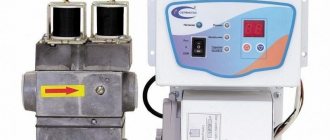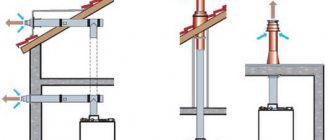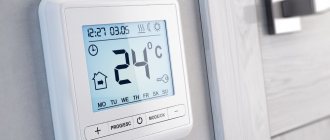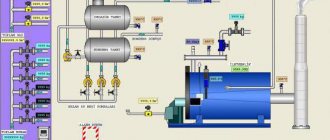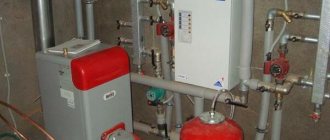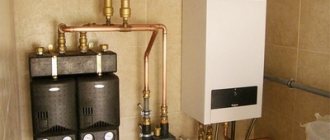Possibility of boiler operation
Despite the variety of automatic modes, as a rule, only one of the possible ones is used: in which the boiler heats up to the value set on the control panel and continues to maintain it. This mode is acceptable, but not optimal. Based on the coolant temperature, the boiler operates in modulation mode, which is good. At the same time, the boiler devices do not have data about the situation at the facility that serves the heating device. No room temperature data available. There is only one parameter: coolant temperature. When the set value is reached, the boiler power is reduced. Then the heating pad turns off and the device remains idle for some time. As soon as the media temperature drops by a set number of degrees, a restart occurs.
+ The boiler operates in modulation mode.
— Gas consumption increases, since only one parameter affects the boiler power.
Functions
The complex sabc device consists of elements that ensure safe operation of the boiler, namely:
- monitoring the presence of a wick in the burner; when the flame goes out, a special device will shut off the gas supply;
- water temperature control to protect equipment from overheating;
- monitoring the presence of draft; if the chimney stops working, the boiler will be stopped;
- valve ensuring uninterrupted gas supply.
Advice! In addition, the sub is equipped with a thermostat, thanks to which you can regulate the temperature level and gas flow.
How does it work?
Let's figure out how subk works. Operating principle:
- when you press the power button, the igniter starts, until the wick is formed in the igniter, the device instantly cuts off the gas supply;
- after starting the igniter, the gas supply begins and the main burner starts;
- a working burner heats water in the heat exchanger until the temperature of the coolant reaches the level set by the owners;
- at the moment when the coolant reaches the set parameters, the sabc will shut off the gas supply to the main burner (the igniter continues to operate);
- The coolant circulating in the system gradually cools down; when its temperature drops to the level specified in the settings, the automatic device will resume the gas supply to the main burner. If, by the time the coolant cools down, the wick on the igniter goes out, the gas supply will not resume.
Connecting the thermostat
When connecting a conventional thermostat to the boiler (as an element of automation), operating comfort increases and gas consumption is reduced. This occurs due to the fact that the boiler is controlled by a sensor installed in the thermostat itself and turns off the burner when the set air temperature is reached in the room.
Taking into account the fact that the volume of air in the room is several times (or even tens of times) greater than the volume of the coolant, its cooling rate is several times lower than the rate of temperature drop in the boiler.
However, in this operating mode it is impossible to adjust the coolant temperature using the thermostat itself. Therefore, the value on the boiler is most often set to the calculated maximum. This is done to ensure that the boiler reaches the set temperature as quickly as possible. However, this method has one negative side. The media temperature either rises to maximum or drops almost to room temperature during idle time. During the off-season, this can lead to uncomfortable sensations. The radiator is either cold or hot - this is not very convenient.
+ Gas consumption is reduced.
— Temperature range of heating equipment from maximum to room temperature.
Automation for pump
Regulates the operation of the system, controlling many functions, such as, for example, pressure, water distribution.
For normal operation, the following components are required: a manifold that provides water supply, a relay that controls the pump, a pressure gauge that measures pressure, a dry-running sensor that prevents the device from overheating if the water runs out.
All automation responsible for the pump is divided into several models, based on the time of creation:
First generation automation;
The first simplest water supply design. Used to solve simple problems when it is necessary to provide a room with a source of water. It consists of three components: a dry running sensor, a hydraulic accumulator that performs the task of accumulating water and contains a membrane, and a relay that controls water pressure. It usually does not cause any difficulties during installation, since the system completely eliminates complex electrical circuits. The mechanism is also extremely easy: the order is cyclical—when the water is completely filled, the pump turns off, then the cycle repeats.
Third generation automation
It is a more worthy version of its predecessors, and costs more accordingly. The unit stands out for its greatest reliability, efficiency, improved safety program, and most importantly, maximum accuracy of the device.
To maintain the device in automatic mode, a relay is installed. The mechanism is simple: when the water pressure decreases, the relay starts the system, and similarly, when the pressure increases, it stops.
Thermostat to turn the pump on or off
The most common type of automation for a pump in home heating. Mechanism: first, information is collected from the sensor, then the indicators are compared, the operation of the pump depends on this. For example, if the owner sets the mode to +60 and the hysteresis to +5, then the water must be +65 for the system to start, and for it to stop, the temperature must be +55.
Connecting the chronothermostat
A special case of using automation in the form of a normally open contact thermostat is the use of a chronothermostat. On the thermostat itself, time periods are set and two or three heating levels are set: the lowering temperature is “night” and the temperature is “day”. But in any case, the coolant temperature will be the one set from the control panel.
+ The boiler heating differential is set based on the user's needs.
— The temperature set from the control panel is adjusted manually.
What to look for when choosing a gas boiler
There are many boiler selection criteria that you can consider before purchasing. If you don’t know enough about the issue, then a smart decision would be to read customer reviews and find out the opinions of experts. If you want to figure it out yourself, then you need to consider the following parameters:
- type of gas boiler (floor-standing, wall-mounted);
- heat exchanger material (steel, cast iron, copper);
- number of circuits;
- installation features;
- serviced area;
- energy dependence;
- power and so on.
Also pay attention to the conditions of use. For an apartment and a country house, a store and an office, a warehouse and other facilities, different gas boilers will be required
Connecting an analogue modulating controller
Another possibility for operating boilers is to use, together with the boiler, not a disconnecting thermostat, but an analogue smooth-action regulator. This allows you to control not only the room temperature, but also adjust the burner power due to feedback. Communication with the gas boiler automation is carried out via a wired or wireless line. It becomes possible to track various parameters that depend on a specific model.
Since this will already be an electronic device, it often immediately becomes possible to control the chronoprofile, that is, heating periods and waiting periods for the boiler are set. You can set several different temperature levels.
Operating rules
The operating principle of a gas boiler is quite complex. When using it, many rules must be followed. The main ones are the following:
- The initial start-up of the heating device must be carried out by a professional. He will be able to competently check the correct operation of the device and draw the correct conclusion. Attempts to install and start the boiler yourself often end in failure.
- When using a gas boiler, it must be serviced. Only in this case will it be able to last longer than the period allotted to it by the manufacturer. The fact is that pollution is constantly formed in the combustion chamber, and carbon deposits appear on the inner sides of the pipes. If cleaning is not carried out in time, the efficiency of the boiler will gradually decrease until it completely fails.
- Do not allow the temperature to rise to close to 100°C. This may have a detrimental effect on the device. The optimal temperature for operating a gas boiler is 75-80°C.
- To prevent failure of the device due to an excessive increase in pressure, special elements must be connected: a gas outlet device, a pressure measuring device and a safety valve.
Connecting the Openterm protocol controller
The smooth action controller exchanges an analog signal with the control board. Depending on the rate of heating of the air in the room, it makes adjustments to the temperature supply, reduces the burner power, or, on the contrary, increases it if the temperature is too low.
Another additional feature is that when exchanging data with the boiler control system, a blocking indication can be seen on this controller. That is, if the boiler stops, you can see this without going to the boiler itself, but directly on the display of the sensor located in the room.
+ The device automatically adjusts the heater power based on a number of parameters.
— Quite a high price.
Automation for gas boiler
Electronic and mechanical control units integrated into the heat generator regulate combustion and help maintain the required temperature in the coolant.
Types of automation for heating boilers
The automation works properly, accurately and reliably, increases the efficiency of heating equipment, promotes reasonable consumption of energy resources and makes the operation of the heating system simple, comfortable and absolutely safe.
The automatic system protects heating installations from overloads and activates an emergency shutdown of the gas supply in the event of sudden force majeure circumstances. Additionally, the equipment regulates the level of combustion intensity and current fuel consumption, allowing owners to save money on heating the premises.
The automatic unit has flexible settings and allows the owner to set the most convenient operating parameters for the equipment.
Based on the basic operating principle and design features, automation for gas-powered equipment is divided into:
- energy dependent devices;
- energy-independent devices.
Systems of the first type are complex electronic units that require an uninterrupted electrical supply to operate correctly. The second types of devices are simplified mechanical structures that do not require energy supply.
Type #1 - volatile products
A volatile module is a small electronic device that responds to the supply of a fuel resource. It turns on and off when the main gas valve is activated or closed. It has a complex design and a large number of elements and microcircuits.
Allows owners to solve the following tasks:
- activation or termination of gas supply;
- starting the heating system in automatic mode;
- adjusting the power level of the base burner (due to the presence of a thermostat);
- turning off a running boiler both in emergency situations and within a user-specified mode;
- displaying current indicators on the display (the general level of air temperature in the room, the point to which the working coolant has been heated, etc.).
More sophisticated modules have additional functionality and offer users unlimited and most convenient conditions for monitoring the operation and control of the unit. Electronic panels provide full protection of heating equipment from malfunction of the three-way valve and prevent the boiler from freezing.
If the temperature in the room drops sharply, the “smart” system itself starts the heating equipment and turns it off when the home is filled with comfortable warm air.
The self-diagnosis option available for individual modules prevents operational failures and facilitates the timely identification of faulty parts and assemblies in the system. It makes it possible to notice a breakdown as early as possible and replace some small element even before it creates a real problem for the equipment.
Minor breakdowns of the heating system eventually turn into global complications and entail costs associated with the repair and dismantling (full or partial) of the equipment. Self-diagnosis helps to identify a malfunction and makes it possible to eliminate it in a timely manner.
Electronic automation, responsible for the safe operation of the equipment, ensures uninterrupted operation of the boiler, prevents the system from overheating and shuts off the gas supply in the event of a drop in draft or extinguishment of the flame in the burner.
The range of energy-dependent automation on the market today is pleasingly diverse. Useful and necessary mini-units are produced by world-famous brands and small companies that are just trying to earn their place in the sun.
Volatile automation is presented in the form of a control panel, where the user can set convenient operating parameters for the equipment. The cost of a “smart” element is high, but the costs are justified, because with the help of a control unit you can reduce resource consumption without any damage to your own comfort
Among the models offered there are both very simple products and more advanced units with a programming option.
On them, the user can select the most suitable individual settings for himself and program the system to operate in day/night mode or, based on the weather forecast, set a certain level of heating of the house or apartment for a period of 1 to 7 days.
Type #2 - non-volatile units
Non-volatile automation is simpler and more practical. Control and adjustment are carried out manually using mechanical rotary toggle switches and are not difficult even for those who are far from technology. The device operates completely autonomously and does not need to be connected to a central electrical system.
To heat a residential building and supply hot water to the taps, it is enough to turn the control knob in the direction of increase by 2-3 divisions. If you need to take a bath or shower, the toggle switch must be set to the maximum setting
The product is marked with a digital scale with a list of values from minimum to maximum. To activate, the user selects the desired mark and in this way sets the appropriate operating temperature directly to the boiler.
After these manipulations, the thermostat is connected and takes control of the specified heating mode. The boiler actively works until the room warms up to the desired temperature. Then the thermostat turns off the gas supply to the system and is activated again only when the room gets colder.
The operating principle is based on the specific design of the device. The gas boiler thermocouple built into the heat exchanger is equipped with a special rod. It is made from a special iron-nickel alloy called invar.
The physical characteristics of this advanced material give it the ability to almost instantly capture minimal temperature fluctuations.
If the room becomes too hot or too cold, the size of the rod changes. The connecting valve reacts to this and promptly shuts off or activates the flow of gas to the burner.
The presence of a non-volatile automatic control system allows users to set the most suitable temperature regime in their house or apartment and use fuel economically without overpaying on utility bills
Additionally, non-volatile automation has sensitive draft and flame sensors. If the pressure in the pipe suddenly decreases or the draft level in the chimney drops for some reason, the supply of the resource is immediately stopped and gas leakage can be avoided.
Non-volatile automation costs quite reasonable money and, unlike electronic analogues, does not require the purchase and installation of a stabilizer that controls voltage and equalizes unexpected surges in the central power grid
Correct operation of the flame sensor is ensured by a special plate. During normal and correct operation of the system, it is in a slightly curved state.
In this way, the part holds the shutoff valve in the “ Open ” mode. When the flame becomes smaller, the plate is leveled and the valve closes under its pressure.
Design and operating principle
The automation that controls the operation of a gas boiler consists of many elements, conditionally divided into two subgroups. The first includes mechanisms that ensure the full and safe functioning of the boiler itself. The second includes devices that make it possible to operate the heating system in the most convenient and user-friendly mode.
Components of a security system
Several modules are responsible for the operational safety of the unit:
- Flame controller - consists of two main parts - a solenoid valve and a thermocouple. Shuts off gas promptly and reliably and prevents leakage.
- Thermostat - maintains the set temperature of the coolant and protects the system from overheating. When the coolant cools down to minimum temperatures, the module starts the boiler into operation, and after recording peak-high readings, it turns it off, completely relieving the owners of the need to constantly pay attention to the system.
- The draft control sensor is responsible for stopping the gas supply to the burner in the event of a change in the basic position of the bimetallic plate, thus preventing gas leakage.
- Safety valve - monitors the amount of coolant in the circuit.
In addition to all the above useful qualities, the automation has a number of additional functions that increase the comfort of using the equipment.
The device performs automatic ignition of the gas burner, selects the most effective operating mode, promotes rational consumption of energy resources and conducts independent diagnostics, saving the owners from all these activities.
Operating principle of security automation
Current regulatory documentation says that the safety system for gas boilers must be equipped with a device that stops the operation of the entire system and shuts off the gas supply in the event of an unexpected breakdown or any other force majeure circumstances.
To carry out this task, automation must keep under control such parameters as:
- gas pressure in the system;
- presence of an optimal size flame in the burner;
- full, high-quality traction;
- working coolant temperature level.
When the gas pressure in a non-volatile mechanical system drops to a critical level, the resource supply immediately stops. This happens automatically due to the presence of a valve mechanism set to a certain value.
Volatile electronic devices are designed slightly differently. In them, the above function is performed by a minimum/maximum pressure switch.
As the number of atmospheres increases, the membrane with the rod bends, opening the power contacts of the boiler itself. Gas stops flowing and is not supplied until the pressure level is restored.
It is prohibited by law to independently troubleshoot problems and somehow interfere with the basic functionality of the equipment. Only a qualified specialist - an employee of the gas supply company - can correct any problems that arise.
If the flame disappears in the burner, the thermocouple cools down and stops producing current. After this, the electromagnetic damper in the valve no longer functions and gas stops flowing to the burner. When the thrust drops, the bimetallic plate heats up intensely, changes shape and acts on the valve, causing it to stop supplying fuel.
The coolant temperature is kept under control by a thermostat. It ensures that the user-selected heating mode is maintained, while preventing the system from overheating and failing.
Nuances of the system's functioning
Volatile electronic automation operates based on information received from sensors. The microprocessor and internal controller analyze this data, process it and provide the system with commands that are optimally suited for a particular situation.
In order for electronic automation to function normally for a long time, it is necessary to call a technician annually to inspect the equipment, diagnose the microprocessor and view memory module reports
Mechanics have a slightly different principle. When the boiler is turned off, the internal gas valve is completely closed. At the moment the equipment is started, the washer on the valve is squeezed out and the passage for the fuel resource to the igniter is forced to open. Ignition stimulates heating of the thermocouple and voltage is generated across it.
This resource uses an electromagnet to maintain the valve in the open position. By turning the washer manually, the user can effortlessly adjust the level and power of his heating equipment.
Review of popular models and manufacturers
The market for advanced gas equipment and related elements includes automation from both domestic and foreign manufacturers. According to the principle of operation, all devices are absolutely identical, but in terms of design there are significant differences between them.
The presence of automatic control in the gas heating system makes it possible to comfortably heat the room and rationally use energy resources. With a reasonable approach, savings can range from 30 to 43%
The cost of modules varies over a wide range. Simple mechanical products with a minimum of functions belong to the budget class and are sold at the lowest price. Advanced electronic panels are valued much higher, but provide the user with more extensive options for individual settings and control of operation.
Some devices, such as SABC automation, in addition to basic functions, are equipped with a built-in pressure stabilizer. This allows for more precise adjustment of the operation of gas equipment
Programmable electronic devices are considered luxury. They enable the owner to set an operating plan for the equipment for a long period of time, taking into account seasonal weather conditions and the current outside air temperature.
No. 1 - automatic EUROSIT 630
The automatic non-volatile unit EUROSIT 630 produced by the Italian company Sit Group (Eurosit) occupies a leading position in the market in terms of sales.
It is considered universal and works effectively with parapet and floor-standing boilers with a power from 7 to 24 kW. Switching on/off, igniting the pilot burner and setting the desired temperature are carried out using one handle with a button.
The Eurosit 630 module is a modern unit for controlling gas equipment. Fully complies with international standards and safety requirements for such devices. Has a European quality certificate and a guarantee from the manufacturer
The product is characterized by a high level of reliability, can withstand significant operating loads and has extensive functionality. The structural elements are “hidden” in the housing, to which sensor cables and other connecting tubes are routed.
The ignition time of the heating boiler using the Eurosit 630 automatic system is 10 seconds. Gas is immediately supplied to the system and very soon the room warms up to the set temperature
Inside the unit there is a cut-off valve, a spring valve and a pressure regulator. The gas supply is carried out from below or from the side according to the user’s wishes. In terms of cost, the unit is included in the budget category.
No. 2 - Honeywell 5474 module
The Honeywell 5474 device is manufactured by the German concern Honeywell , which has been specializing in the development and sale of various types of automation for more than a hundred years. Works correctly with domestic gas boilers with a power of up to 32 kW.
Honeywell 5474 is a non-volatile device for controlling the heating system. Equipped with micro-torch burners made of heat-resistant stainless steel. They ensure better gas combustion, reduce the emission of harmful substances into the atmosphere and prevent excess soot from depositing in the chimney
The Honeywell 5474 automatic system is equipped with a basic set of control functions that guarantee efficient operation of the boiler with absolute safety for users.
In automatic mode, the product maintains the specified coolant temperature (from 40 to 90 degrees), turns off the boiler in the event of a fuel supply cutoff, lack of draft at the required level in the chimney, reverse draft occurs, or burner extinguishment.
No. 3 - premium automation from Honeywell
In addition to inexpensive budget models, Honeywell also produces other types of automatic equipment, for example, luxury chronothermostats of the premium ST series or programmed thermostats Honeywell YRLV430A1005/U.
The YRLV430A1005/U device, with the widest possible functionality, has a user-friendly interface and does not cause any difficulties for customers during use. The cost of the product is quite high, but still lower than that of competitors offering models with similar characteristics
These electronic panels allow you to set the heating equipment the most detailed and precise settings, up to changing the temperature several times a day depending on the time of day, weather conditions and personal wishes.
No. 4 - Orion device
The Orion automatic device is manufactured in Russia. The device includes a piezoelectric ignition and a draft sensor.
The Orion device looks simple and has a minimal set of functions. Its capabilities are not too great, but, thanks to its reasonable price and basic control method, the unit is in demand
The device turns off the gas in case of random extinguishing of the burner or lack of the required draft. When the room temperature drops, the thermostat activates the fuel supply and the boiler resumes operation.
The transition to the flame reduction mode when a certain (user-specified) temperature is reached occurs automatically and allows you to save fuel resources.
Conclusions and useful video on the topic
A detailed description of the operating principle of automation designed for a gas boiler. Interesting features and nuances of monitoring equipment:
How does the automation of a gas heating boiler work? A visual demonstration of the process of igniting a gas unit:
A detailed description of one of the most popular automation models designed for controlling and adjusting a gas boiler:
An automatically controlled gas heating system is a practical and cost-effective option for home heating equipment. .
The mechanical controller is distinguished by its low price, reliability and simple control method. The electronic panel is more expensive, but has advanced functionality that allows you to create the most comfortable conditions in the room.
It is better to purchase mini-units in company stores that sell certified products that meet all the requirements for elements of gas-powered heating systems.
Do you know the intricacies of gas equipment automation that are not mentioned in the article? Did you have any questions while reading the material? Please write comments, share your own opinions and photographs on the topic of the article.
Connecting weather-compensated automation
Some boiler models are equipped with the ability to use weather-dependent automation that supports the Openterm protocol. Due to the use of an external temperature sensor, additional variables appear that make it possible to more quickly adjust the burner power and supply temperature, depending on the changing conditions outside the building. Such automation is capable of switching to summer mode on its own: turning off the heating, which will be an additional saving on gas consumption.
+ Intelligent control of the heating device, requiring minimal intervention from the owner, saving fuel.
— Quite a high price.
Pros and cons of homemade structures
There is only one advantage: you can make a design yourself that is ideal for the free space in the apartment.
Of the obvious disadvantages:
- A homemade horizontal bar is unlikely to cost less than a purchased one. You will have to spend around 1000 rubles on the material alone - not to mention the costs of welding and cutting metal (if you don’t do it yourself). A simple wall horizontal bar will cost around 1500-2000 if you buy a new one in the store. That is, this method cannot be called economical.
- Expenses by time. Depending on the model, you will have to spend at least 2-3 hours on manufacturing and fastening (not counting calculations and going to the store for materials).
- The difficulty of metal processing at home. If you don’t have a free garage, basement or workshop, you’ll have to work with metal in your apartment. It is noisy, dirty, and can stain (at least with metal filings) the interior.
To summarize: a homemade horizontal bar is worth making if you like to make something, or want to get something unusual that is not in the store.
Complexity
As you might have guessed, creating a horizontal bar at home is difficult. Plus, if you don’t have a workshop, a garage, or at least a basement, you’ll have to work with metal right in your apartment. And this will be quite noisy, dirty and, again, possibly costly (if, for example, you stain the interior).
Thus, a homemade horizontal bar is the lot of jacks of all trades or people who no longer know what to do with themselves in self-isolation. In all other cases, we advise you to buy ready-made sports equipment.
Time
As we all know very well, time is as valuable a resource as money. But if you decide to start making a horizontal bar, be prepared to spend more than one hour on it. First of all, you will have to order all the necessary materials, then calculate the dimensions of the structure, start processing the metal, welding it, and so on. For unprepared people, even a week may not be enough.
About loads
Already when pulling up, a short-term mechanical load on the horizontal bar can reach 2.5 times the weight of the student, i.e. up to 200 or more kgf. When performing relatively simple exercises such as inversions or muscle-ups, this value doubles.
Gymnastic bars, on which you can spin the sun, are designed for instantaneous loads of 1200-1700 kgf, and, nevertheless, cases when the bar came off the horizontal bar in competitions are known. Therefore, a home horizontal bar for slow exercises without a swing should hold at least 200-250 kg, and a street bar should hold at least three to four times more.
Automation from different manufacturers
Wall-mounted gas boiler
If we talk about a standard wall-mounted gas boiler, then it can operate according to the coolant temperature. A room thermostat or chronothermostat can be connected to it. It is also possible to connect an openterm protocol regulator.
A special case of using wall-mounted boilers is the possibility of using weather-dependent automation. Due to the use of an external temperature sensor, additional variables appear that make it possible to more quickly adjust the burner power and supply temperature, depending on the changing conditions outside the building.
Automation Arbat
The devices have 5 degrees of protection. There is thermoelectric flame protection. The gas supply is blocked when switched off. A modulating thermostat will provide comfort in use, and a coarse mesh filter will extend its service life.
Some models are equipped with a circulation pump. The device distributes the coolant evenly throughout the heating system. It is also possible to connect to an external thermostat inside or outside the room.
Automation Honeywell
Honeywell has a wide range of automation systems for gas boilers, from the most budget (mechanical) to multifunctional automatic systems.
Main features:
- the coolant automatically maintains the temperature;
- turning off the boiler in case of gas supply interruptions;
- shutdown in the absence of draft or during reverse draft;
- blocking the gas supply when the gas burner goes out.
Some models are equipped with programmable automation with the ability to set temperature periods depending on the time of day, weather, and even develop a heating/cooling mode by day of the week. And the Smile series models control several temperature circuits at once (heating, ventilation, “warm floor”, hot water, etc.).
Popular brands
The most common brands of automation for gas boilers are:
- Orion;
- Honeywell;
- Vakula.
Orion
This is an easy-to-use and reliable automatic system for controlling the operation of gas equipment. This type of automation is equipped with a sensor that monitors the presence of traction, as well as piezoelectric ignition, system properties:
- the ability to instantly interrupt the gas supply in the event of an emergency;
- maintain the coolant temperature within the specified parameters.
This device weighs about 1.5 kilograms.
Honeywell
This is a common automation system and one of the trusted brands. Honeywell brand devices are presented in a wide range, there are both very simple samples and quite complex devices. But even the cheapest and simplest version of the automation system can ensure complete safety for the inhabitants of the house.
Vakula
Another common brand of device for automatically adjusting the operation of a heating unit, which has the following properties:
- makes it possible to set the coolant temperature in a wide range;
- equipped with a reliable piezoelectric element for ignition;
- it is possible to regulate the gas supply not only to the main burner, but also to the room burner;
- automation of this brand will ensure stable operation of the boiler even with reduced gas supply pressure;
- the device will turn off the equipment if any emergency occurs.
To ensure stable and safe operation of heating equipment, automatic equipment for gas heating boilers is used. Thanks to the presence of this device, owners do not need to constantly monitor the operation of the unit; all processes in it will be carried out automatically.
Safety rules for operating an automatic boiler
Despite the fact that all modern models of heating equipment, including solid fuel boilers, are equipped with various automatic devices that maximize the safety of their operation, the owner of the cottage should take some measures in this direction.
In particular, the following requirements apply to the installation site of the equipment:
- The boiler can only be installed in a specially designated room that meets fire safety standards.
- The room should be equipped with efficient supply and exhaust ventilation, preferably the forced type (with an electric fan).
- The boiler must be mounted on a specially equipped durable pedestal or foundation made of concrete.
- The boiler room should be equipped with a chimney to remove combustion products.
To install the boiler, a separate room is equipped that complies with fire safety regulations.
How does the automatic temperature control system work?
The simplest system of automatic control of a set temperature using a gas burner works like this: gas is supplied to the burner, which is ignited by the ignition function, and thus constant combustion occurs. At the same time, the burner itself operates at full power. When a certain temperature of the coolant or air in the room is reached, the automatic gas burner extinguishes the fire.
To maintain the set temperature, the burner is constantly turned on and off.
Types of control blocks
Control units are available for:
- single or two-stage diesel burners with a capacity of up to 30 kg/h, with or without an oil heater and intermittent operation;
- two-stage atmospheric gas burners;
- two-stage supercharged and combined burners (gas/diesel);
- two-stage supercharged and combined gas burners (gas/diesel), with the ability to connect an air damper servo drive, etc.
